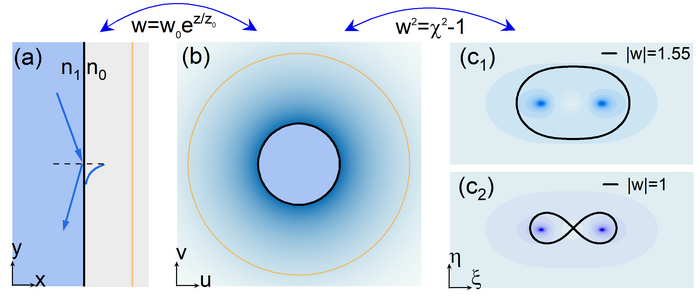The whispering-gallery-mode (WGM) cavity is an intriguing system that allows light–matter interaction to be greatly improved. It forms the basis for nonlinear optics, ultra-sensitive sensing, ultra-low threshold lasers, and quantum photonics.
 Mapping the homogeneous refractive index distribution in the original straight space (a) to a circular OBH cavity (b) with gradient index. The core region of the OBH cavity is truncated as the homogeneous index. The quadrupole cavity (c1) and peanut-like cavity (c2) are transformed from the circular OBH cavity under different structural parameters. Image Credit: Qingtao Ba, Yangyang Zhou, Jue Li, Wen Xiao, Longfang Ye, Yineng Liu, Jin-hui Chen and Huanyang Chen.
Mapping the homogeneous refractive index distribution in the original straight space (a) to a circular OBH cavity (b) with gradient index. The core region of the OBH cavity is truncated as the homogeneous index. The quadrupole cavity (c1) and peanut-like cavity (c2) are transformed from the circular OBH cavity under different structural parameters. Image Credit: Qingtao Ba, Yangyang Zhou, Jue Li, Wen Xiao, Longfang Ye, Yineng Liu, Jin-hui Chen and Huanyang Chen.
The traditional WGM cavity is made up of homogeneous materials that possess a constant refractive index both in the cladding and core. The light field is, on the one hand, limited to the cavity via the total internal reflection (TIR) and, on the other hand, improved by constructive interference. The ultrahigh-Q factor has been achieved in numerous dielectric WGM cavities with angular momentum and a large mode volume (V).
However, the intrinsic radiation loss in an open boundary cavity with a finite dielectric constant is pervasive because of the light tunneling of the curved surface from the quantum mechanics analog. This radiation loss is extraordinarily boosted and becomes the dominant loss mechanism when the resonant wavelength is akin to the cavities’ geometry size.
There is a persistent effort to enhance the Q/V in optical cavities, which is extremely crucial in studying cavity quantum electrodynamics (QED).
A team of researchers guided by Professor Huanyang Chen and Dr. Jin-hui Chen from Xiamen University explored WGM cavities. Their article, published in eLight, suggested and showed an optical black hole (OBH) cavity that established transformation optics.
Several methods have been recommended to exploit the radiation loss and enhance the Q-factor. For instance, the plasmonic cavity was built by using the robust optical-field localizations of metals. Nevertheless, the intrinsic ohmic loss in the plasmonic system is inevitable.
Conversely, the radially anisotropic claddings were executed to compress additional energy into the cavity’s core, creating tighter optical confinement and a considerably higher Q-factor. However, the anisotropic factors are still quite hard to carry out for natural materials.
Transformation optics (TO) is an extremely versatile technique for exploiting light rays and electromagnetic fields with unique functionalities. The majority of the interesting optical structures developed by TO allow light deflection and trapping to imitate the cosmology effects.
The researchers utilized the TO theory to design a category of OBH cavities. The WGM fields beyond the core of the circular OBH cavity are revealed to follow an unusual decay rule from conformal mapping. Using the operative potential model, the researchers were able to prove that the radiation loss of WGM in the perfect OBH cavity can be entirely prevented; therefore, the radiation Q-factor is unlimited.
The researchers also showed the Q-factor improvement and tight field confinement of the condensed OBH cavity, which was compared to a homogeneous cavity in the microwave spectra. Additionally, the circular OBH cavity can be applied to the randomly-shaped cavities, including multi-core and single-core structures with high Q-factor.
This study opens the way for surface field exploitation with conformal transformation. It can be adapted to resonant modes of numerous wave platforms, such as elastic and acoustic waves, and can be employed in optoelectronics and energy harvesting.
Journal Reference:
Ba, Q., et al. (2022) Conformal optical black hole for cavity. eLight. doi.org/10.1186/s43593-022-00026-y.